Operation Optimization of Medium-Depth Ground Source Heat Pump (MD-GSHP) Systems Based on the Improved Particle Swarm Algorithm
Abstract
:1. Introduction
2. System Description
2.1. Calculation of Heating Load
2.2. Buried Pipe Model
2.3. Model Validation
2.4. Heat Pump Model
2.5. Heat Storage Tank Model
2.6. Water Pump Model
3. Improvement of Particle Swarm Optimization Algorithm
3.1. Particle Swarm Algorithm Model
3.2. Improvement of the Particle Swarm Algorithm
3.3. Objective Function
3.4. Constraint Condition
- ①
- Thermal power balance constraint.
- ②
- Water pump flow rate constraint.
- ③
- Heat storage capacity constraint.
4. Results and Discussion
4.1. Operating Costs as the Objective Tunction
4.2. System COP as the Objective Function
4.3. Geothermal Energy Utilization Coefficient as the Objective Function
4.4. Improvement of the Particle Swarm Algorithm
5. Conclusions
- Taking the operating costs as the objective function, the buried pipe flow rate first decreases from approximately 14 m3/h to 8.5 m3/h and then increases to 11 m3/h with 18:00 as the demarcation point, and the higher power consumption of the system in 21:00–10:00, about 25–30 kW. At the same time, the working conditions of the heat storage tank are mainly divided into three stages, 2:00–10:00, 20:00–24:00, which is the heat release mode, and 12:00–20:00, which is the heat storage mode. The heat storage capacity first changes from approximately 300 kW to 0 in 2:00–10:00, then from 0 to 150 kW in 20:00–24:00, and then to 0 in 12:00–20:00. Furthermore, the system transfers some of the power consumption from the peak power period to the valley power period by switching the heat storage and heat release modes of the heat storage tank. In this way, the operating cost is the lowest, CNY 279.27. The system COP and the geothermal energy utilization coefficient are 5.8257 and 0.8369, respectively.
- Taking the system COP as the objective function, the buried pipe flow rate fluctuates slightly at a high level, with a maximum of 14 m3/h and a minimum of 11.75 m3/h. However, the system power consumption varies little with time, staying at around 27 kW. In this way, the working conditions of the heat storage tank are mainly divided into two stages: 1:00–10:00 is the heat release mode, and 10:00–20:00 is the thermal storage mode. The heat storage capacity first changes from approximately 250 kW to 0 in the 1:00–10:00 stage, and then from 0 to approximately 460 kW in the 10:00–20:00 stage. In addition, the heat supply of the system is maintained at a relatively stable level at all times by switching the heat storage and heat release modes of the heat storage tank. In this case, the maximum system COP is 6.4420. The operating cost and the geothermal energy utilization coefficient are 300.02 and 0.8524, respectively.
- Taking the geothermal energy utilization coefficient as the objective function, it can be seen that the optimization effects are similar to the effect of taking the system COP as the objective function. At this time, the maximum geothermal energy utilization coefficient is 0.8527. The operating cost and the system COP are 300.74 and 6.4413, respectively.
- Comparing the three objective functions, it can be revealed that the operating costs are opposite to the optimization effects of the system COP, while the values of the geothermal energy utilization coefficient are not much different under different objective functions.
Author Contributions
Funding
Institutional Review Board Statement
Informed Consent Statement
Data Availability Statement
Acknowledgments
Conflicts of Interest
Nomenclature
| GSHP | Ground Source Heat Pump |
| MD-GSHP | Medium-Depth Ground Source Heat Pump |
| HTF | Heat Transfer Fluid |
| PSO | Particle Swarm Optimization |
| IPSO | Improved Particle Swarm Optimization |
| TES | Thermal Energy Storage |
| COP | Coefficient of Performance |
| q | rate of flow/m3 h−1 |
| ρ | density/kg m−3 |
| R | thermal resistance/m K W−1 |
| d | drilling diameter/m |
| λ | thermal conductivity/W m−1 K−1 |
| h | convective heat transfer coefficient/W m−2 K−1 |
| μ | dynamic viscosity/N s m−1 |
| T | temperature/K |
| Q | heating capacity/kW |
| H | height of water pump/m |
| Ld | load rate/% |
| P | heat storage power/kW |
| η | efficiency of water pump |
| n | speed of water pump/r min−1 |
| w | inertia weight |
| c | acceleration factor |
| r | random variable |
| i | number of iterations |
| e(t) | electricity price of t/¥ kWh−1 |
References
- Wang, F.H.; Cai, W.L.; Wang, M.; Gao, Y.; Liu, J.; Wang, Z.H.; Xu, H. Status and outlook for research on geothermal heating technology. J. Refrig. 2021, 42, 14–22. (In Chinese) [Google Scholar] [CrossRef]
- Li, J.; Xu, W.; Li, J.F.; Li, Z.; Zhang, Y.Q.; Yang, C.; Qiao, B.; Sun, Z.Y.; Wang, X.; Xiao, L.; et al. Heat supply technology review and engineering measurement analysis of medium and deep buried pipes. HVAC 2020, 50, 35–39. (In Chinese) [Google Scholar]
- Zhang, B.B. Study on Energy Efficiency of Medium-Depth Borehole Casing Type Buried Pipe Heat Exchanger and Ground Source Side Water System; Shandong Architecture University: Jinan, China, 2019. (In Chinese) [Google Scholar]
- Ren, Y.Z. Experimental Study on Medium Medium-Depth Soil Source Heat Pump System in Severe Cold Area; Harbin Institute of Technology: Harbin, China, 2019. (In Chinese) [Google Scholar]
- Deng, J.W.; Wei, Q.P.; Liang, M.; He, S.; Zhang, H. Field test on the energy performance of medium-depth geothermal heat pump systems (MD-GHPs). Energy Build. 2019, 184, 289–299. [Google Scholar] [CrossRef]
- Pratiwi, A.S.; Trutnevyte, E. Life cycle assessment of shallow to medium-depth geothermal heating and cooling networks in the State of Geneva. Geothemics 2020, 90, 101988. [Google Scholar] [CrossRef]
- Zuo, T.T.; Li, X.L.; Wang, Z.S. Application of medium-depth double U-tube ground-source heat pump systems to severe cold zone. HVAC 2021, 51, 118–123. (In Chinese) [Google Scholar]
- Wang, W. Optimization analysis of the operation strategy of medium and deep ground source heat pump heating system. Build. Energy Build. 2022, 41, 62–67. (In Chinese) [Google Scholar]
- Du, S.S. Design load ratio analysis of medium and deep ground source heat pump heating system with auxiliary heat source in northwest China. Northwest. Hydropower 2022, 1, 95–98+102. (In Chinese) [Google Scholar]
- Ma, J.X.; Zhang, X.G.; Yao, X.Y.; Li, Y. Design and application of medium-depth geothermal heating system in a residential district of Xianyang. HVAC, 2022; 52, 200–204. (In Chinese) [Google Scholar]
- Wang, X.Y.; Zhou, C.H.; Ni, L. Experimental investigation on heat extraction performance of deep borehole heat exchanger for ground source heat pump systems in severe cold region. Geothemics 2022, 105, 102539. [Google Scholar] [CrossRef]
- Guo, H.M.; Wu, J.H.; Hu, P.F.; Ren, H.J.; Zhang, J.; Li, Z.X. The measurement and analysis for a medium-depth geothermal heat pump system. China Min. Mag. 2023, 32, 165–172. (In Chinese) [Google Scholar]
- Zhao, B.; Guo, C.X.; Cao, Y.J. An improved particle swarm optimization algorithm for optimal reactive power dispatch. In Proceedings of the 2005 IEEE Power Engineering Society General Meeting, San Francisco, CA, USA, 12–16 June 2005; pp. 272–279. [Google Scholar]
- Mussetta, M.; Selleri, S.; Pirinoli, P.; Zich, R.E.; Matekovits, L. Improved particle swarm optimization algorithms for electromagnetic optimization. J. Intell. Fuzzy Syst. Appl. Eng. Technol. 2008, 19, 75–84. [Google Scholar]
- Zhang, R.; Zhang, Q.; Wang, B. Improved particle swarm optimization algorithm for designing DNA codewords. Inf.-Int. Interdiscip. J. 2009, 12, 497–505. [Google Scholar]
- Gu, W.; Li, X.Y.; Wang, Y.H. Design of subsynchronous damping control based on improved particle swarm optimization algorithm by STATCOM. In Proceedings of the 2010 Asia-Pacific Power and Energy Engineering Conference (APPEEC), Chengdu, China, 28–31 March 2010; pp. 2903–2906. [Google Scholar]
- Liu, N.P.; Zheng, F.; Xia, K.W. CDMA multiuser detection based on improved particle swarm optimization algorithm. In Proceedings of the International Conference on Intelligent Structure and Vibration Control (ISVC 2011), Chongqing, China, 14–16 January 2011; Volume 50–51, pp. 3–7. [Google Scholar]
- Ma, X. Optimal operation of hydropower station based on improved particle swarm optimization algorithm. In Proceedings of the International Conference on Advanced Research on Computer Science and Information Engineering, Zhengzhou, China, 21–22 May 2011; Volume 153, pp. 226–231. [Google Scholar]
- Kumar, N.; Nangia, U.; Sahay, K.B. Economic load dispatch using improved particle swarm optimization algorithms. In Proceedings of the 6th IEEE Power India International Conference (PIICON), Delhi, India, 5–7 December 2014; pp. 1–6. [Google Scholar]
- Cao, H.Q.; Xu, J.; Ke, D.P.; Jin, C.X.; Deng, S.C.; Tang, C.H.; Cui, M.J.; Liu, J. Economic dispatch of micro-grid based on improved particle-swarm optimization algorithm. In Proceedings of the 48th North American Power Symposium (NAPS), Denver, CO, USA, 18–20 September 2016. [Google Scholar]
- Song, Z.K.; Wang, P.; Bai, L.Q. Optimization of pulse CVT based on improved particle swarm algorithm. In Proceedings of the 2nd International Conference on Materials Science, Machinery and Energy Engineering (MSMEE 2017), Dalian, China, 13–14 May 2017; Atlantis Press: Dordrecht, The Netherlands; Volume 123, pp. 835–839. [Google Scholar]
- Luo, Y.Q.; Zeng, B. An intelligent scheduling method based on improved particle swarm optimization algorithm for drainage pipe network. AIP Conf. Proc. 2017, 1864, 020037. [Google Scholar]
- Luo, K.Y. Power system fault harmonic analysis based on improved particle swarm optimization algorithm. AIP Conf. Proc. 2019, 2066, 020015. [Google Scholar]
- Wang, W.; Peng, C.; Mi, H.Y.; Chen, C.L.; Zeng, D.L. Furnace flame recognition based on improved particle swarm optimization algorithm. Proc. Inst. Mech. Eng. Part I-J. Syst. Control. Eng. 2020, 234, 888–899. [Google Scholar] [CrossRef]
- Ahmadi, S.; Sahnesaraie, M.A.; Talami, S.H.; Dini, F.; Zanganeh, M.M.; Ashgevari, Y. Determine the optimal switching angles symmetrical cascaded multilevel inverter using Improved particle swarm optimization algorithm. In Proceedings of the 18th IEEE World Symposium on Applied Machine Intelligence and Informatics (SAMI 2020), Herlany, Slovakia, 23–25 January 2020; pp. 329–335. [Google Scholar]
- Tao, Q.Y.; Sang, H.Y.; Guo, H.W.; Wang, P. Improved particle swarm optimization algorithm for AGV path planning. IEEE Access 2021, 9, 33522–33531. [Google Scholar]
- Cai, M.Z. Dormitory allocation method oriented to heuristic particle swarm genetic algorithm. In Proceedings of the 2nd International Conference on Artificial Intelligence and Information Systems (ICAIIS ’21), Chongqing, China, 28–30 May 2021; p. 51. [Google Scholar]
- Feng, K.T.; Li, X.Y.; Qian, X.; Wu, L.H.; Zheng, H.; Chen, M.; Li, M.R.; Liu, B. Atmospheric optical turbulence profile model fitting based on improved particle swarm algorithm. Laser Optoelectron. Prog. 2022, 59, 0501002. (In Chinese) [Google Scholar]
- Ioakimidis, C.S.; Thomas, D.; Rycerski, P.; Genikomsakis, K.N. Peak shaving and valley filling of power consumption profile in non-residential buildings using an electric vehicle parking lot. Energy 2018, 148, 148–158. [Google Scholar] [CrossRef]
- Fang, C.; Xu, Q.; Wang, S.; Ruan, Y. Operation optimization of heat pump in compound heating system. Energy Procedia 2018, 152, 45–50. [Google Scholar] [CrossRef]
- Bandyopadhyay, A.; Leibowicz, B.D.; Beagle, E.A.; Webber, M.E. As one falls, another rises? Residential peak load reduction through electricity rate structures. Sustain. Cities Soc. 2020, 60, 102191. [Google Scholar] [CrossRef]
- Nouri, G.; Noorollahi, Y.; Yousefi, H. Designing and optimization of solar assisted ground source heat pump system to supply heating, cooling and hot water demands. Geothermics 2019, 82, 212–231. [Google Scholar] [CrossRef]
- Diao, N.R. Buried Pipe Ground Source Heat Pump Technology; Higher Education Press: Beijing, China, 2006; pp. 21–22. (In Chinese) [Google Scholar]
- Gordon, J.M.; Kim, C.N.; Hui, T.C. Centrifugal chillers: Thermodynamic modeling and a diagnostic case study. Int. J. Refrig. 1995, 18, 253–257. [Google Scholar] [CrossRef]
- Bernier, B.M.A.; Bourret, B. Pumping energy and variable frequency drives. ASHRAE J. 1999, 41, 37–40. [Google Scholar]
- Kennedy, J.; Eberhart, R. Particle swarm optimization. In Proceedings of the ICNN’95-International Conference on Neural Networks, Perth, WA, Australia, 27 November–1 December 1995; pp. 1942–1948. [Google Scholar]
- Tang, X.L. The Theory and Application of Particle Swarm Optimization Algorithm Based on Chaos; Chongqing University: Chongqing, China, 2007. (In Chinese) [Google Scholar]
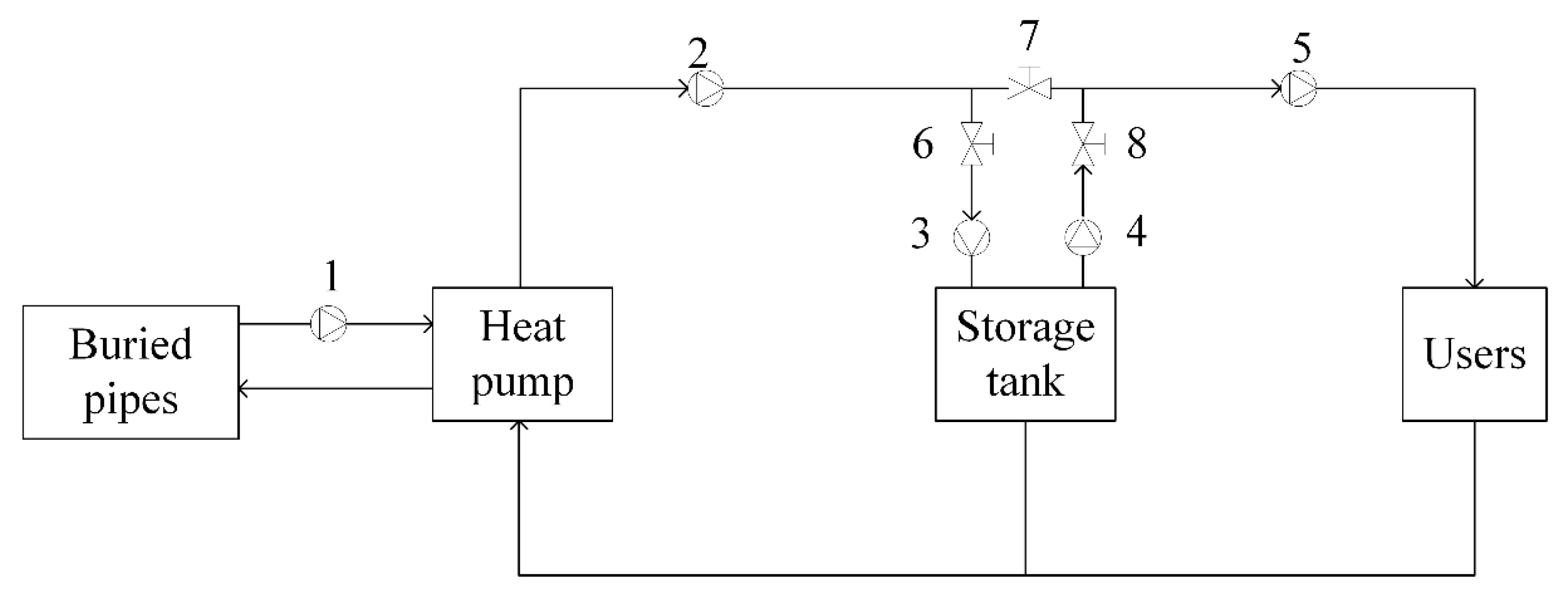
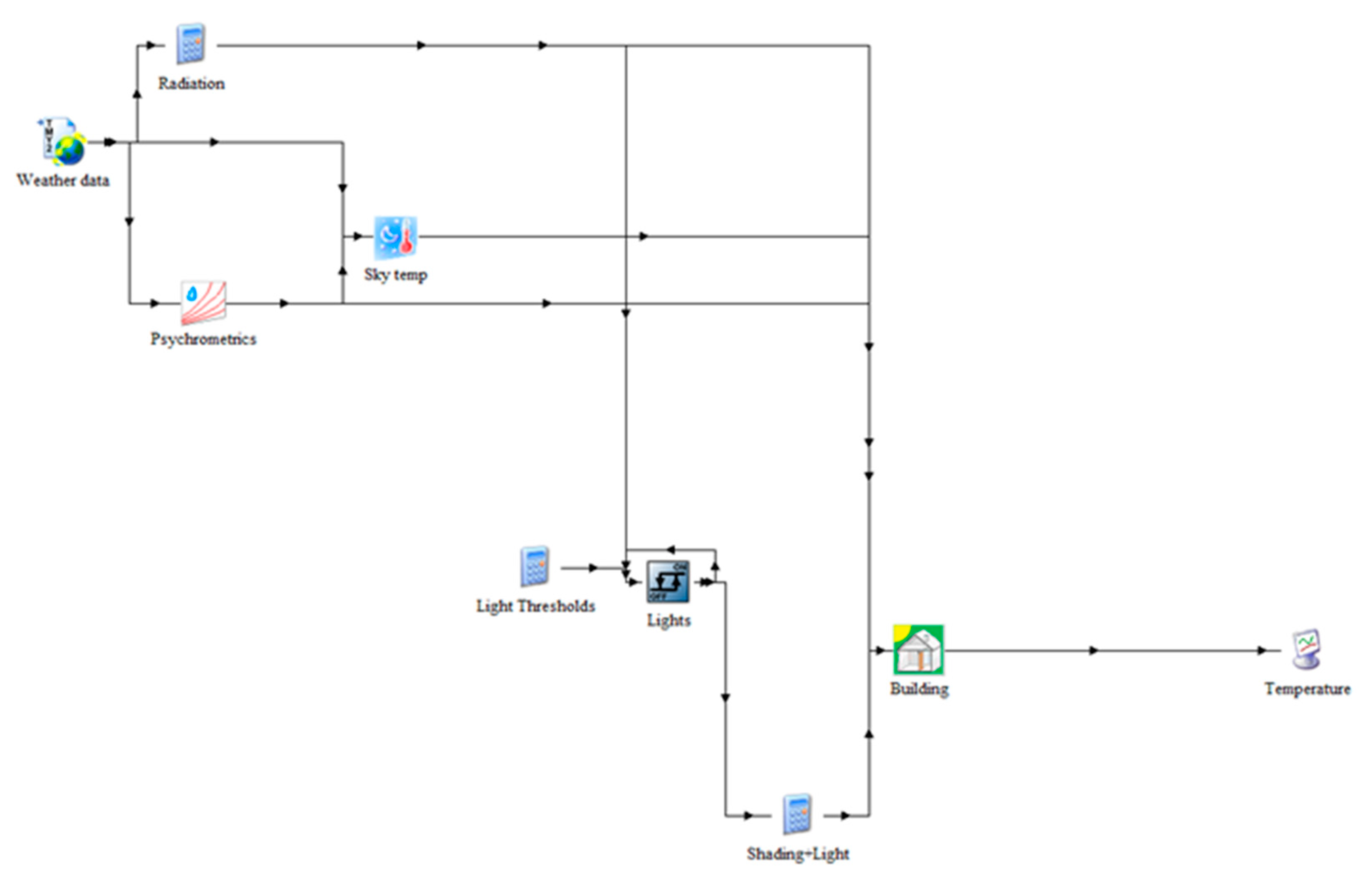
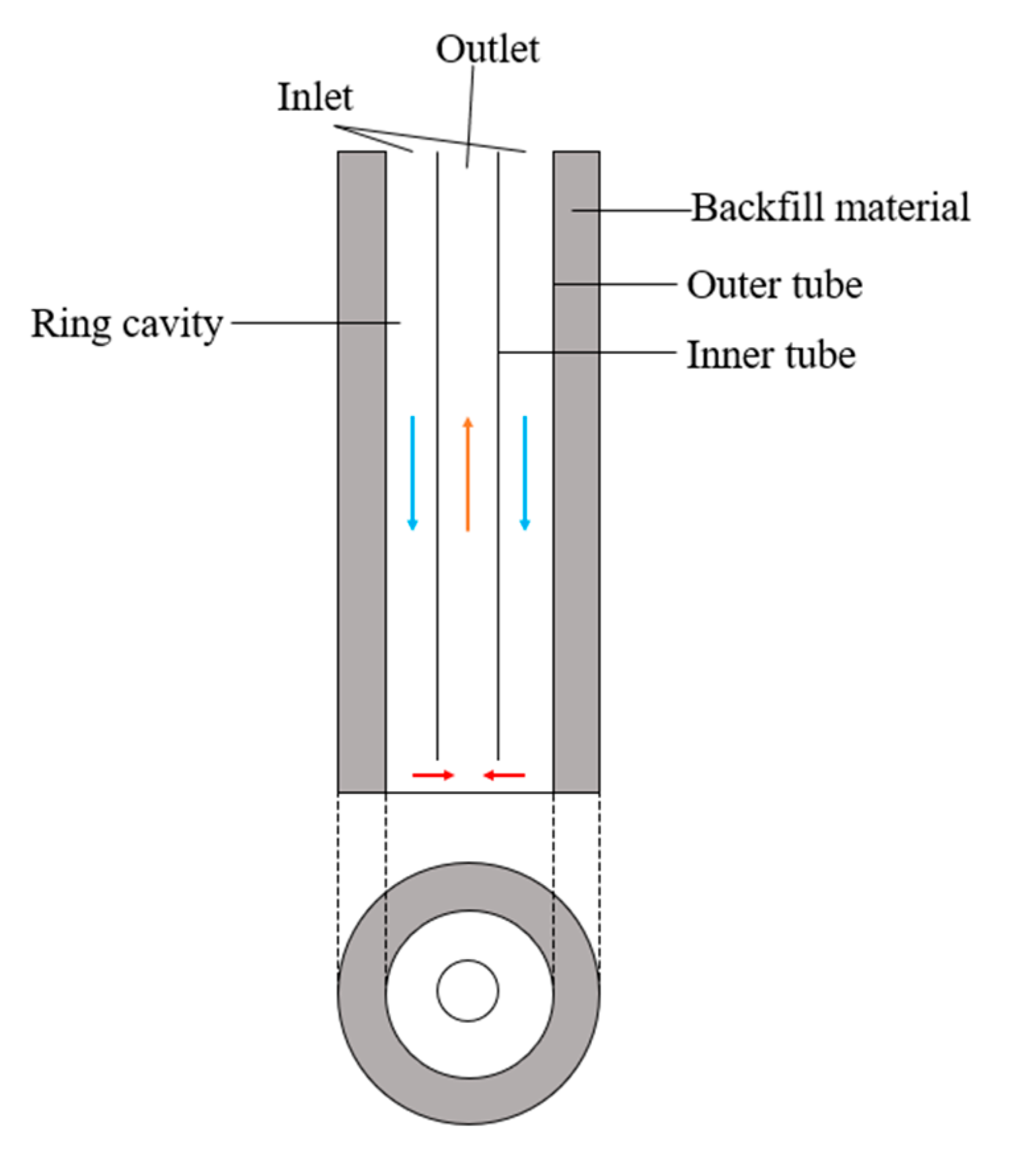
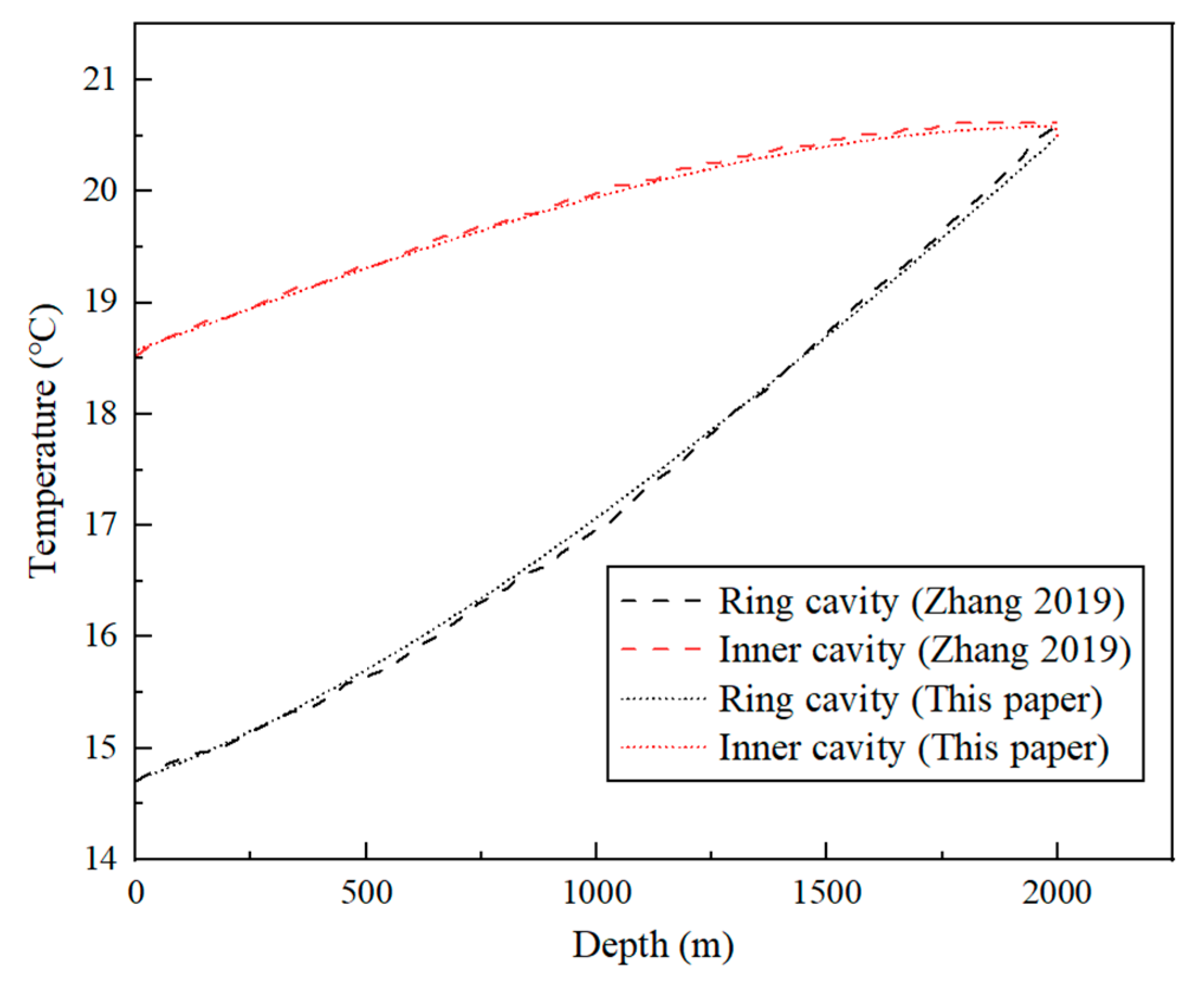
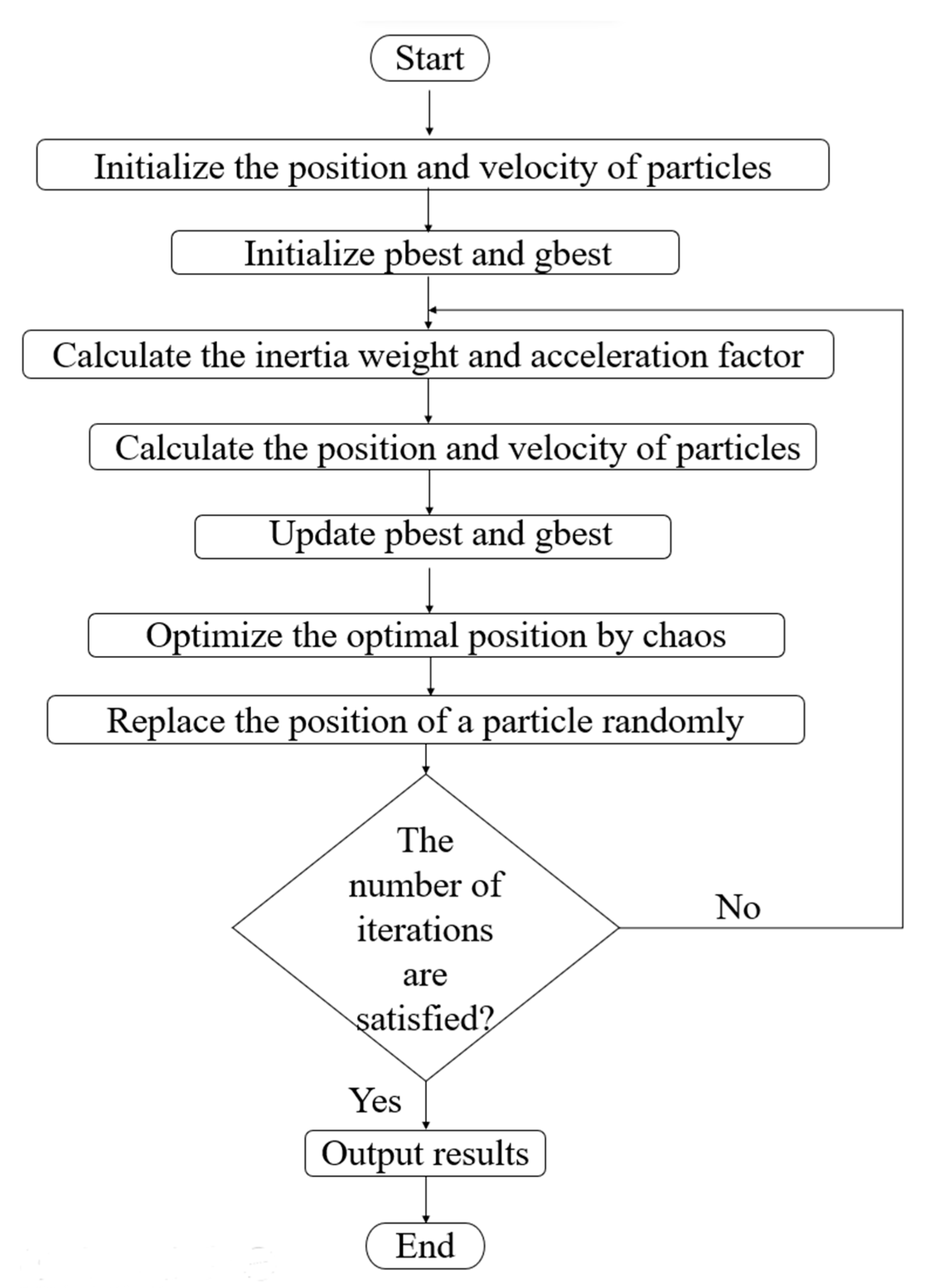
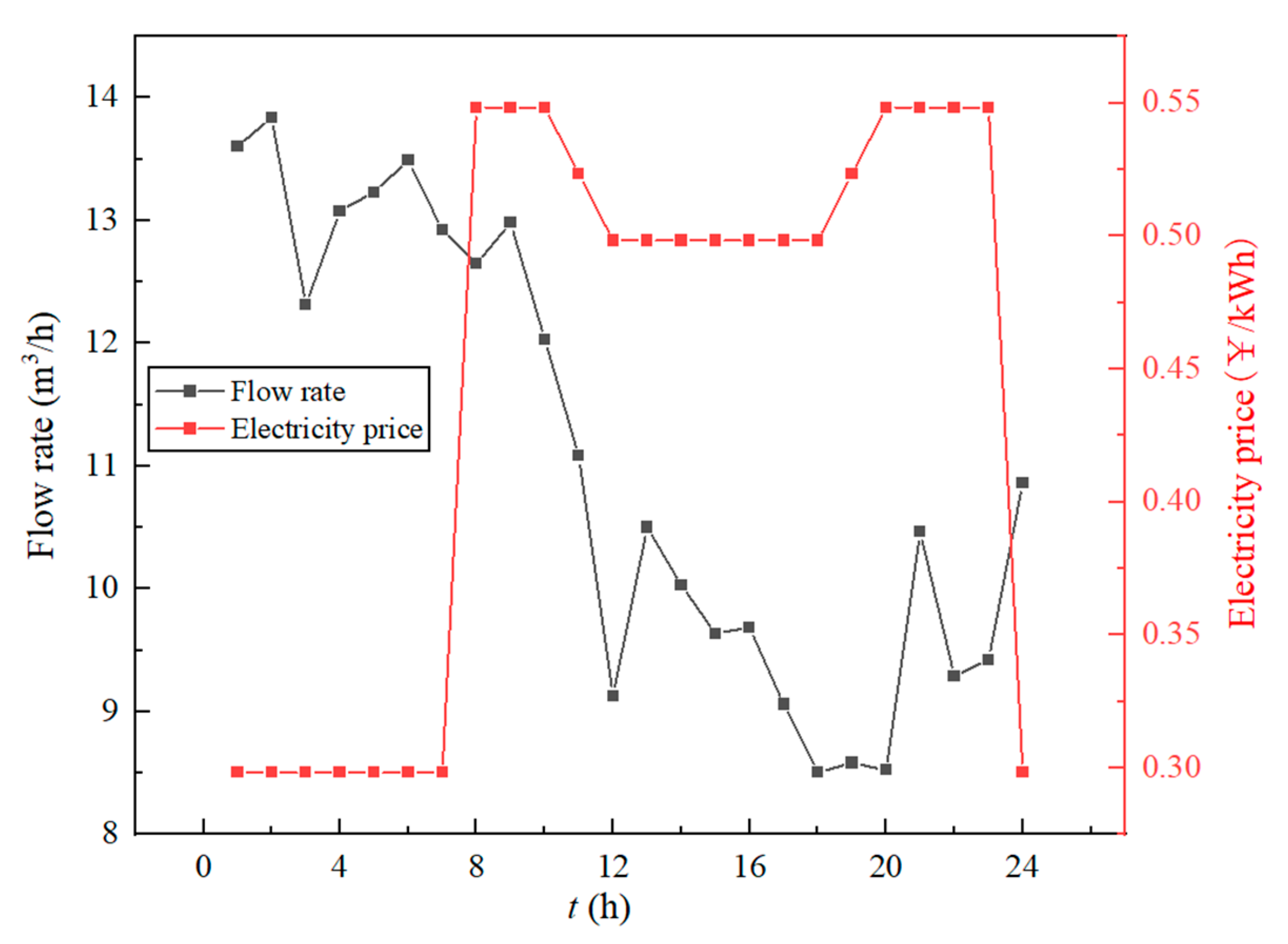
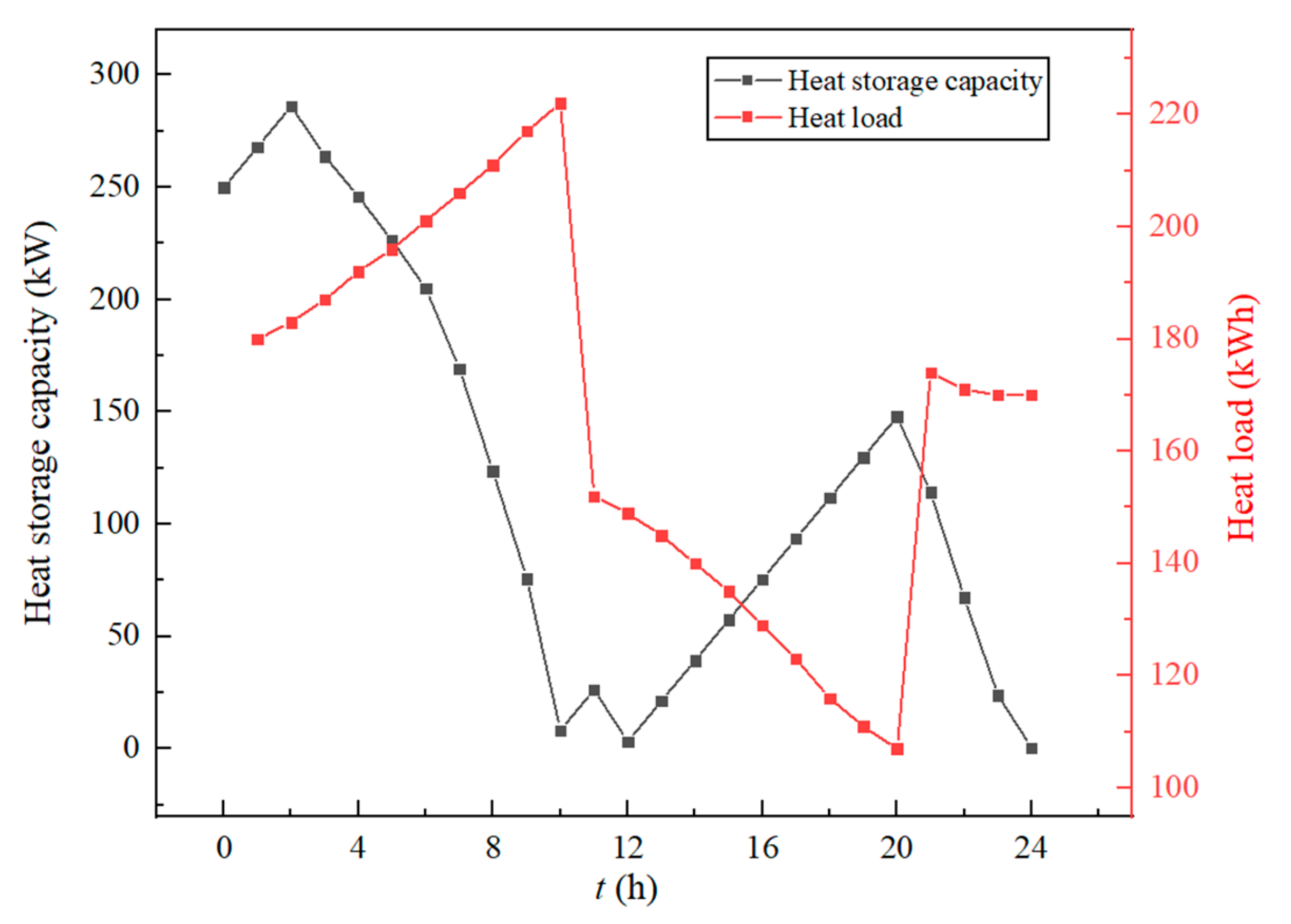
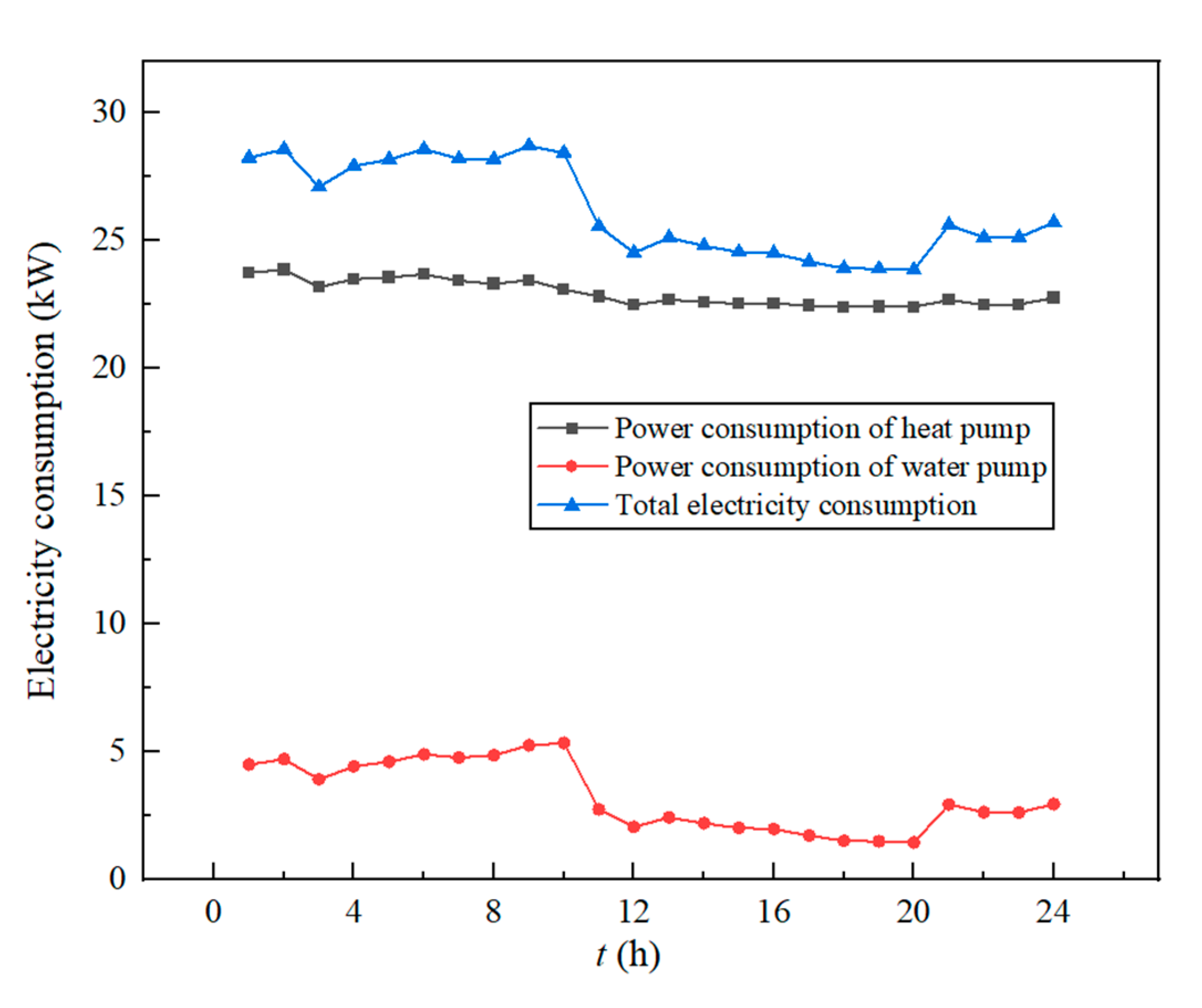
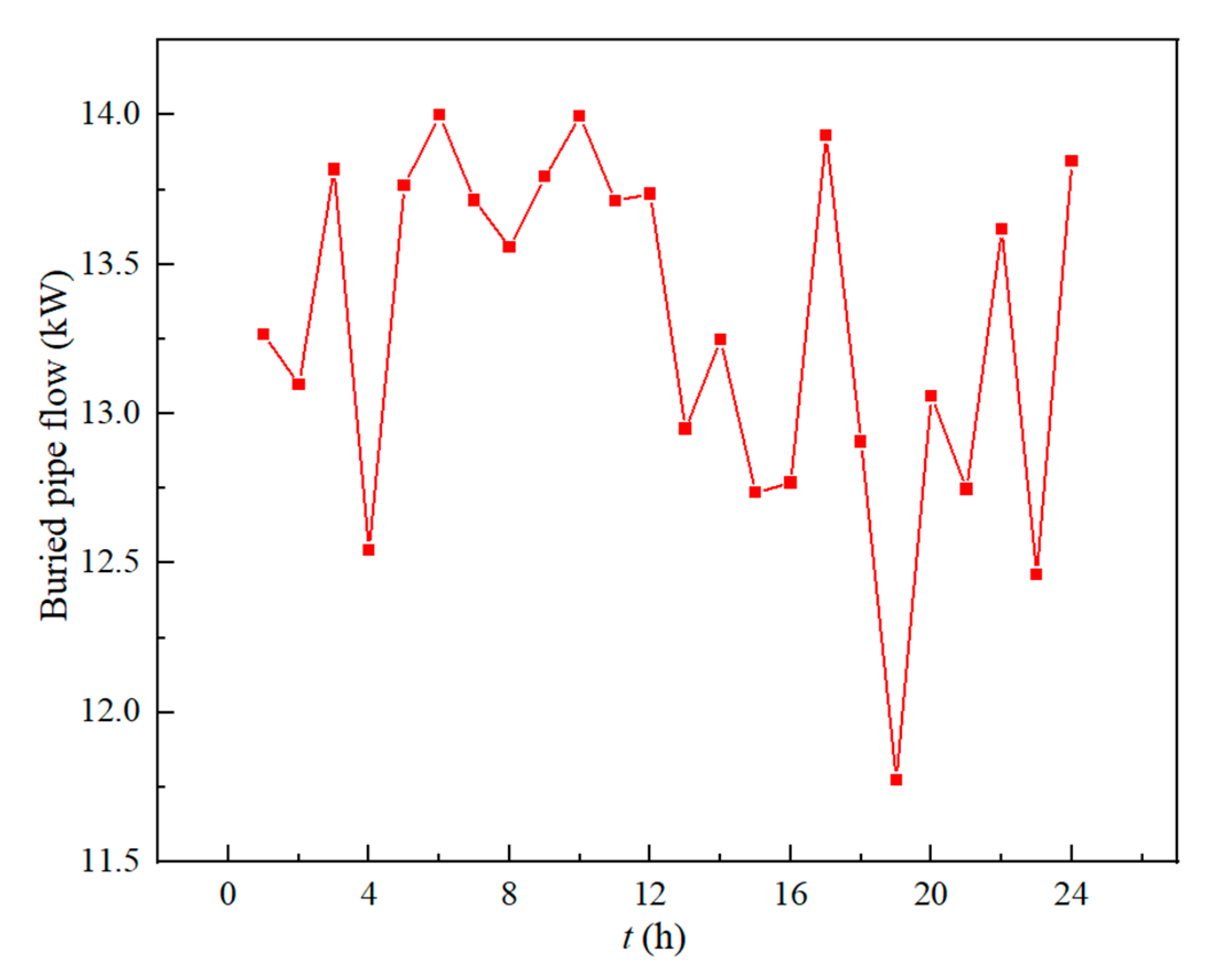
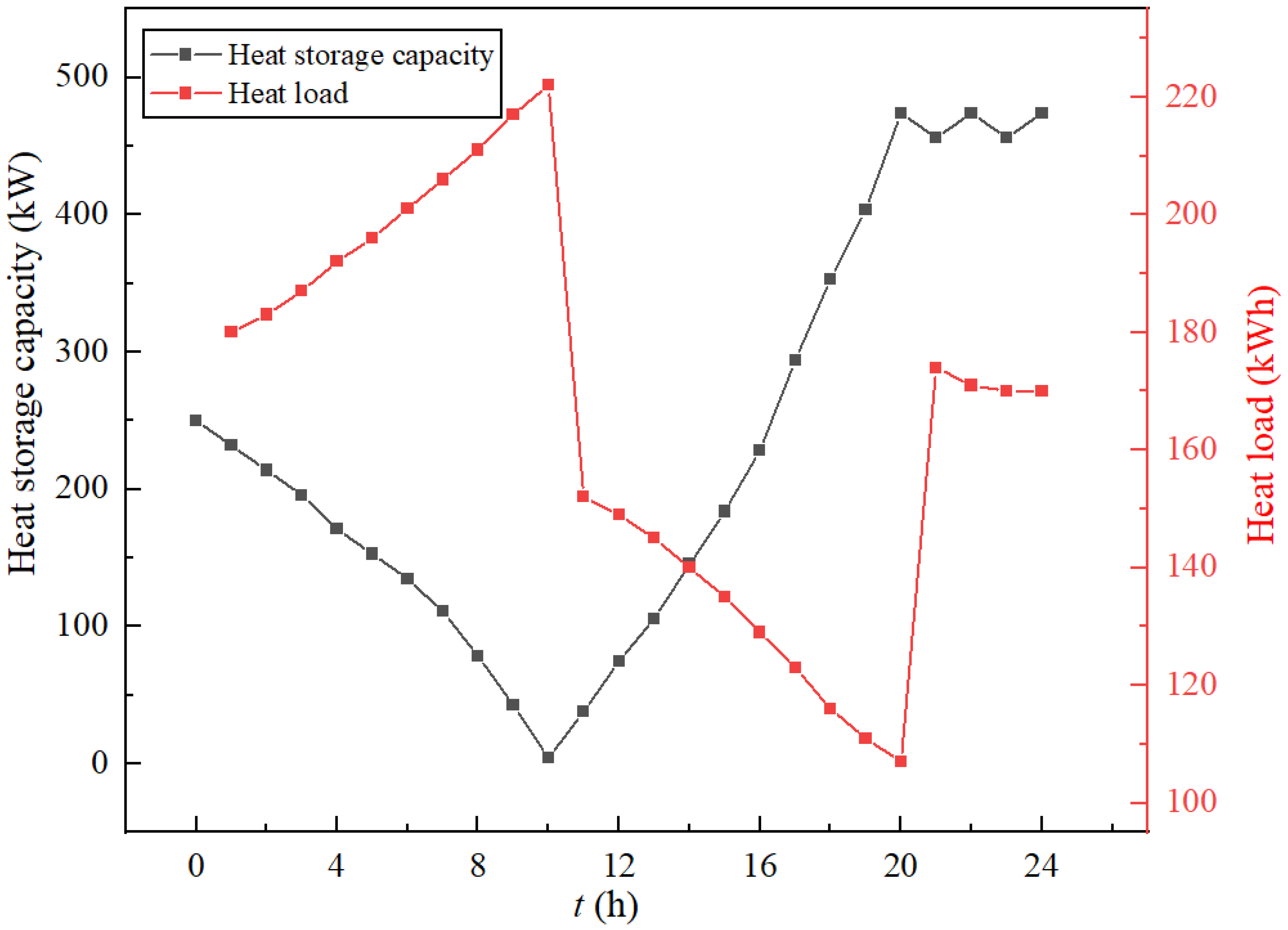
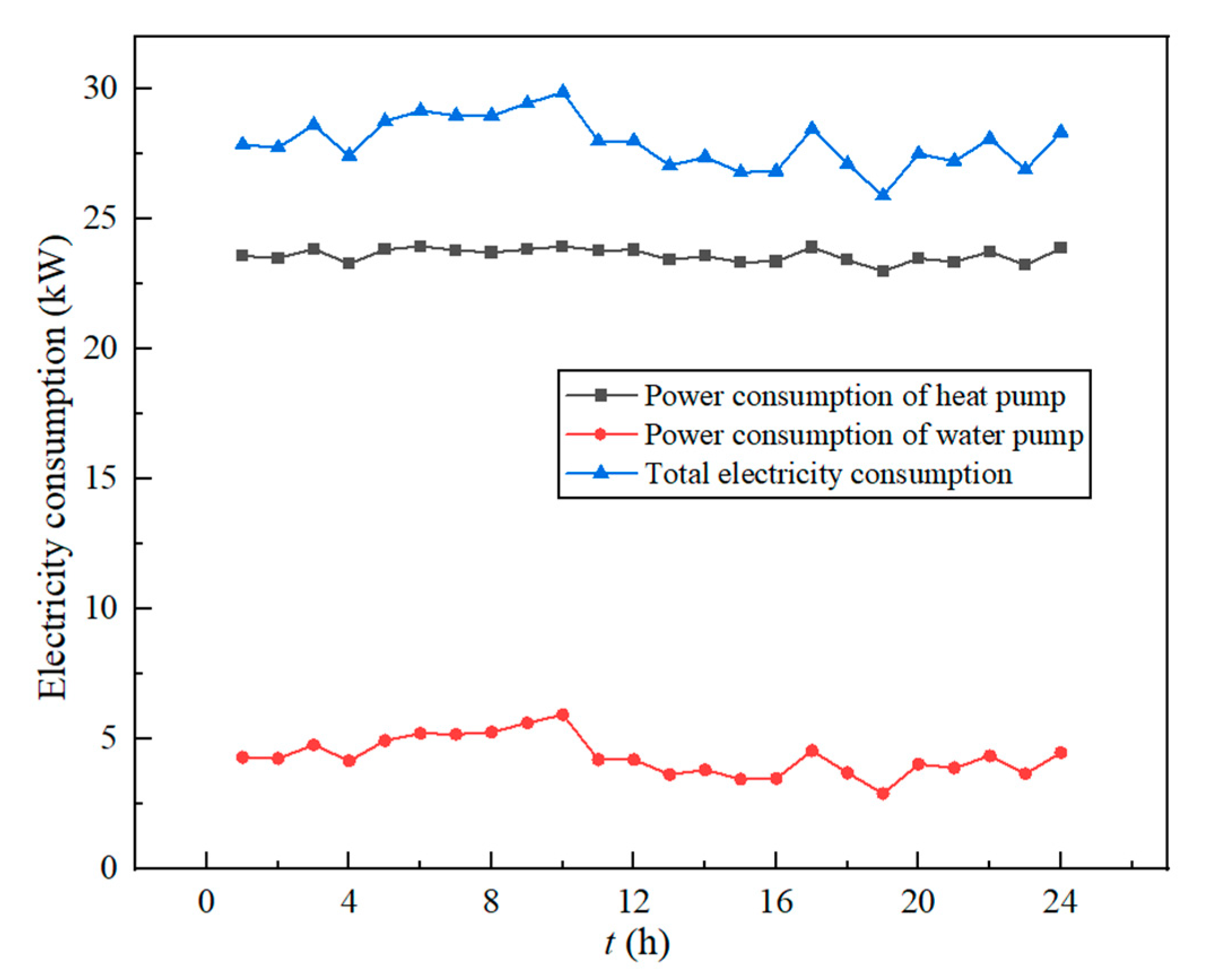
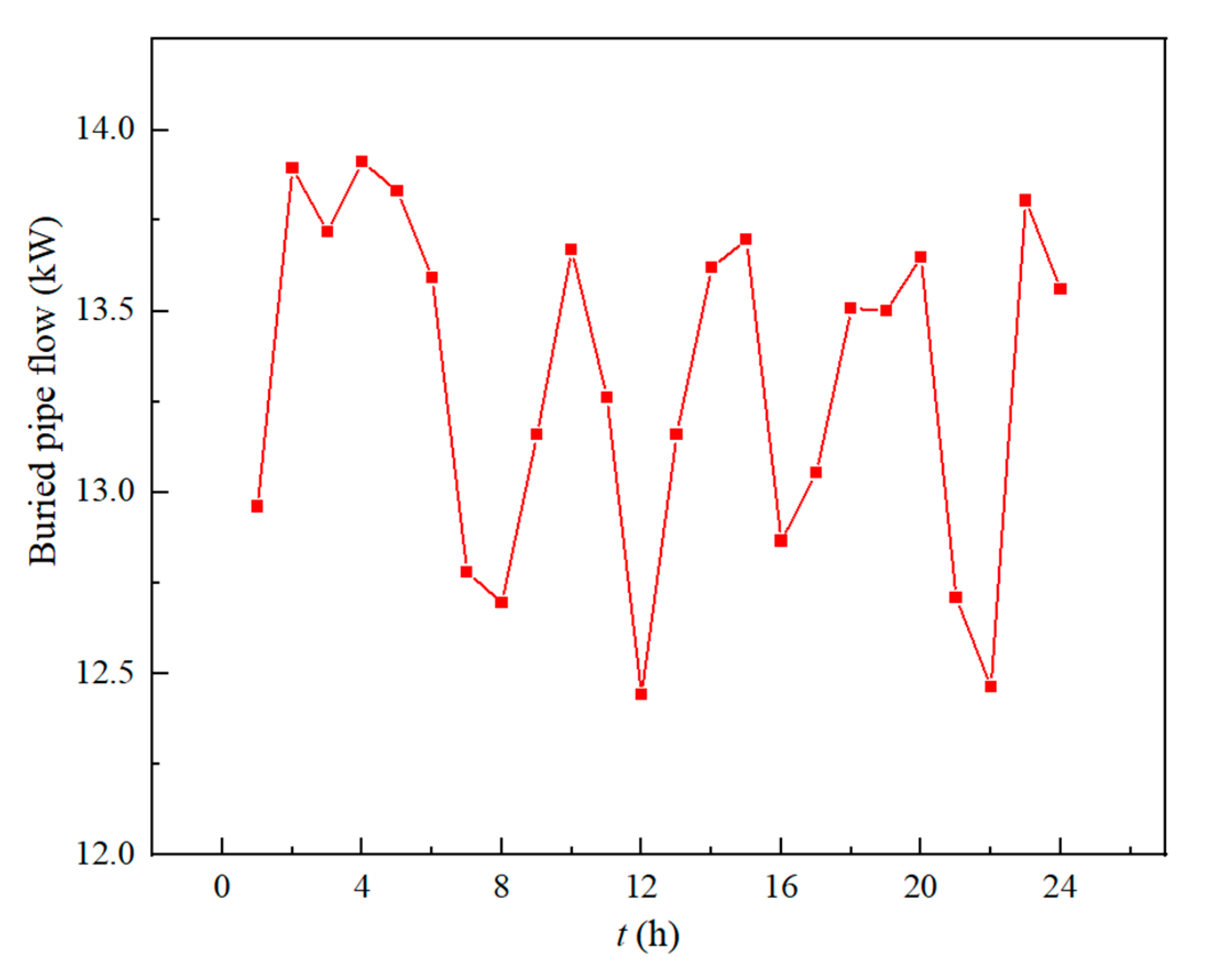

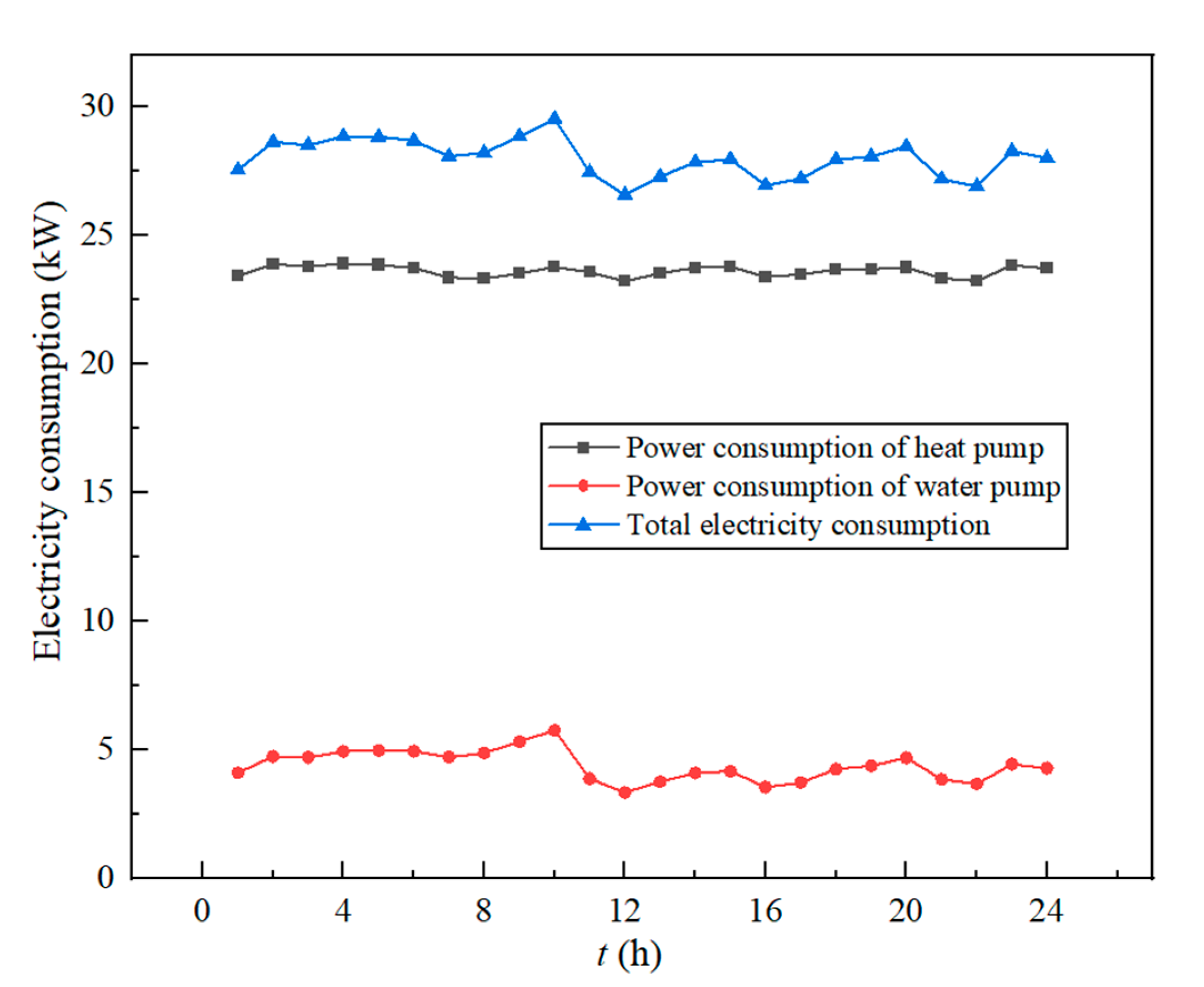
| Parameter | Value |
|---|---|
| Drilling depth | 2000 m |
| Drilling diameter | 0.28 m |
| Outer diameter of outer tube | 177.8 mm |
| Inner diameter of outer tube | 159.42 mm |
| Outer diameter of inner tube | 110 mm |
| Inner diameter of inner tube | 90 mm |
| Thermal conductivity of outer tube | 41 W/(m·K) |
| Thermal conductivity of inner tube | 0.4 W/(m·K) |
| Thermal conductivity of backfill material | 1.8 W/(m·K) |
| Objective Functions | Operating Costs (CNY) | System COP | Geothermal Energy Utilization Coefficient |
|---|---|---|---|
| Operating costs | 279.27 | 5.8257 | 0.8369 |
| System COP | 300.02 | 6.4420 | 0.8524 |
| Geothermal energy Utilization coefficient | 300.74 | 6.4413 | 0.8527 |
Disclaimer/Publisher’s Note: The statements, opinions and data contained in all publications are solely those of the individual author(s) and contributor(s) and not of MDPI and/or the editor(s). MDPI and/or the editor(s) disclaim responsibility for any injury to people or property resulting from any ideas, methods, instructions or products referred to in the content. |
© 2023 by the authors. Licensee MDPI, Basel, Switzerland. This article is an open access article distributed under the terms and conditions of the Creative Commons Attribution (CC BY) license (https://creativecommons.org/licenses/by/4.0/).
Share and Cite
Zhu, C.; Li, B.; Wang, Y.; Zhang, J.; Quan, C. Operation Optimization of Medium-Depth Ground Source Heat Pump (MD-GSHP) Systems Based on the Improved Particle Swarm Algorithm. Appl. Sci. 2023, 13, 3821. https://doi.org/10.3390/app13063821
Zhu C, Li B, Wang Y, Zhang J, Quan C. Operation Optimization of Medium-Depth Ground Source Heat Pump (MD-GSHP) Systems Based on the Improved Particle Swarm Algorithm. Applied Sciences. 2023; 13(6):3821. https://doi.org/10.3390/app13063821
Chicago/Turabian StyleZhu, Chao, Biao Li, Yueshe Wang, Jian Zhang, and Chen Quan. 2023. "Operation Optimization of Medium-Depth Ground Source Heat Pump (MD-GSHP) Systems Based on the Improved Particle Swarm Algorithm" Applied Sciences 13, no. 6: 3821. https://doi.org/10.3390/app13063821





